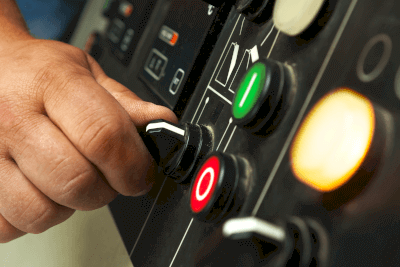What Is an Operation Switch?

An operation switch is an input device operated mechanically by an external force to switch electrical signals.
These switches are essential for toggling circuits in equipment and device control systems. Their operation involves moving an actuator through direct actions like pressing a button, pulling a lever, or turning a knob.
Consequently, the internal contacts either make or break the circuit, enabling or preventing current flow.
Uses of Operation Switches
Operation switches play a pivotal role in control and power systems, facilitating actions such as power toggling, command issuance, and equipment switching. They enable operators to start, modify, or stop machines during operation.
Operation boxes, or control boxes, house these switches and, increasingly, also feature programmable displays and panel computers as modern input methods.
Principle of Operation Switches
Take the toggle switch as an example: it comprises a body, lever, contacts, and terminals. Activating the lever moves the contacts to switch the circuit ON or OFF.
1. Types of Contacts
Contacts, responsible for circuit continuity, come in three types:
Make Contact (a-contact)
This type remains open (OFF) until operated to close (ON), facilitating load activation.
Break Contact (b-contact)
Normally closed (ON), this contact opens (OFF) upon operation, used for load deactivation.
Break-Make Contact (c-contact)
This contact combines both functions, switching between ON and OFF states upon operation, ideal for circuit toggling.
2. Poles and Throws
The terms “pole” and “throw” denote the switch’s circuit control capabilities, with variations including:
- Single Pole Single Throw (SPST): Controls 1 circuit with 1 contact
- Double Pole Single Throw (DPST): Controls 2 circuits with 1 contact
- Single Pole Double Throw (SPDT): Controls 1 circuit with 2 contacts
- Double Pole Double Throw (DPDT): Controls 2 circuits with 2 contacts
3. Operation Modes
Switches may operate in alternate or momentary modes, exemplified by push-button switches:
- Alternate
Maintains the actuator’s position and contact state post-operation. - Momentary
Resets to the original state upon releasing the switch.
Types of Operation Switches
Variations of operation switches are distinguished by the actuator’s shape and motion, including:
1. Pushbutton Switch
These switches engage contacts via a button press, available in alternate and momentary modes.
Specialized emergency stop switches are designed for visibility and rapid activation.
2. Selector Switch
Selector switches alter contacts through lever rotation, with specifications like notch number and angle, dictating switching capabilities and lever positioning.
3. Rocker Switch
Rocker switches, with their distinctive shape, toggle contacts by pressing a paddle, similar to common light switches.
4. Toggle Switch
These switches operate by moving a lever, with variations supporting different positioning and actuation types.
5. Tactile Switch
Tactile switches are characterized by their short stroke and distinct feedback.
6. Rotary Switch
Rotary switches control circuits through knob rotation, differing from selector switches in internal design.
7. Slide Switch
Operated by sliding a lever, slide switches are another form of tactile actuation.
8. Key Lock Switch
Keylock switches require a key for operation, providing secure access and control.
9. Touchless Switch
These innovative switches detect hand presence without physical contact, employing near-infrared technology for hygienic operation.
10. RFID Switch
Utilizing RFID technology, these switches offer secure, personalized control through tag recognition.